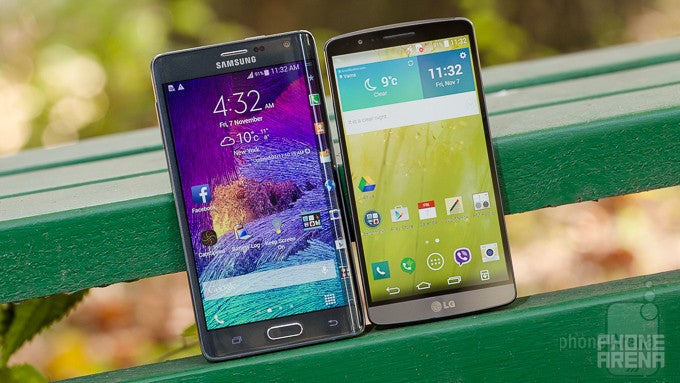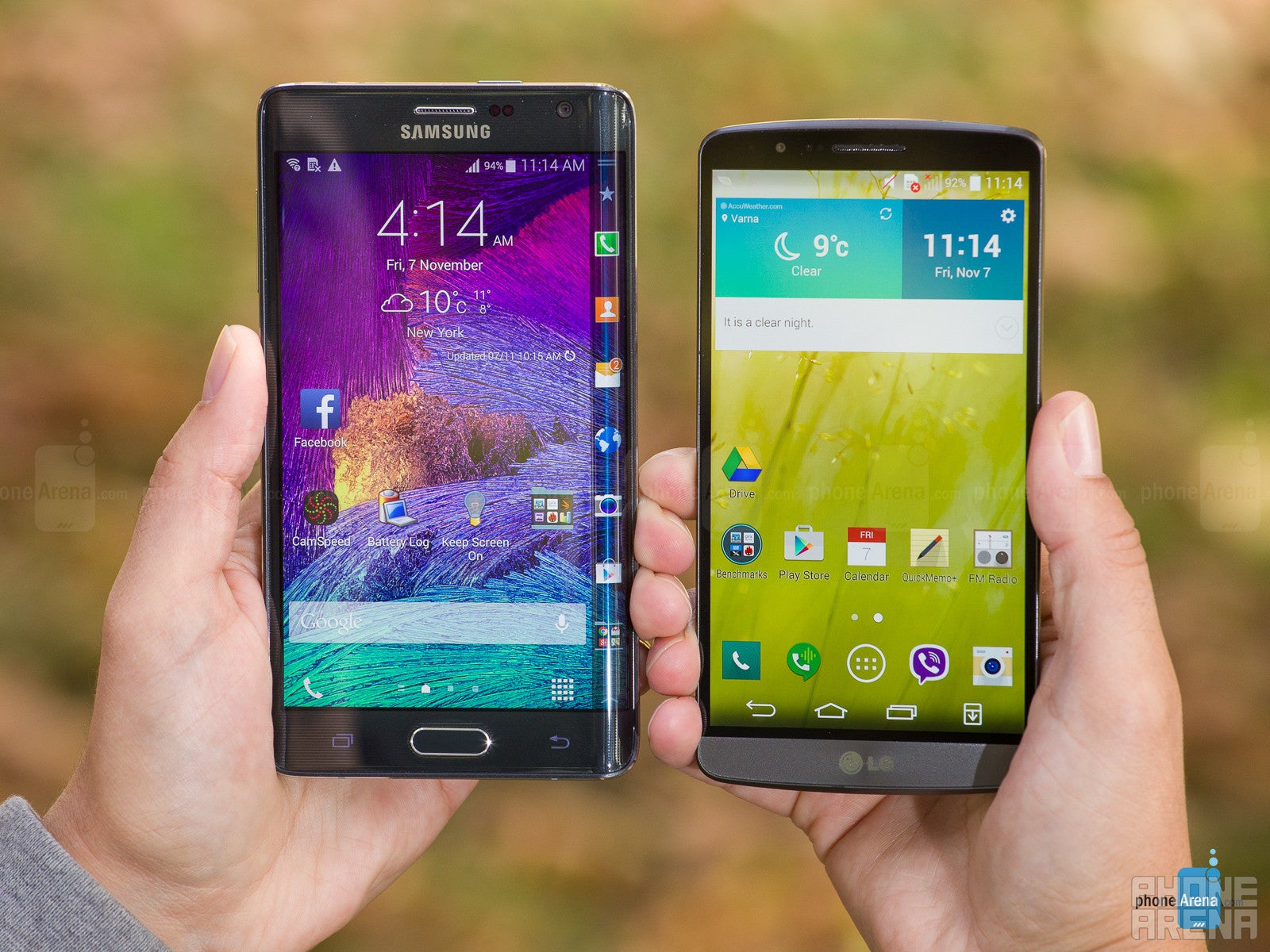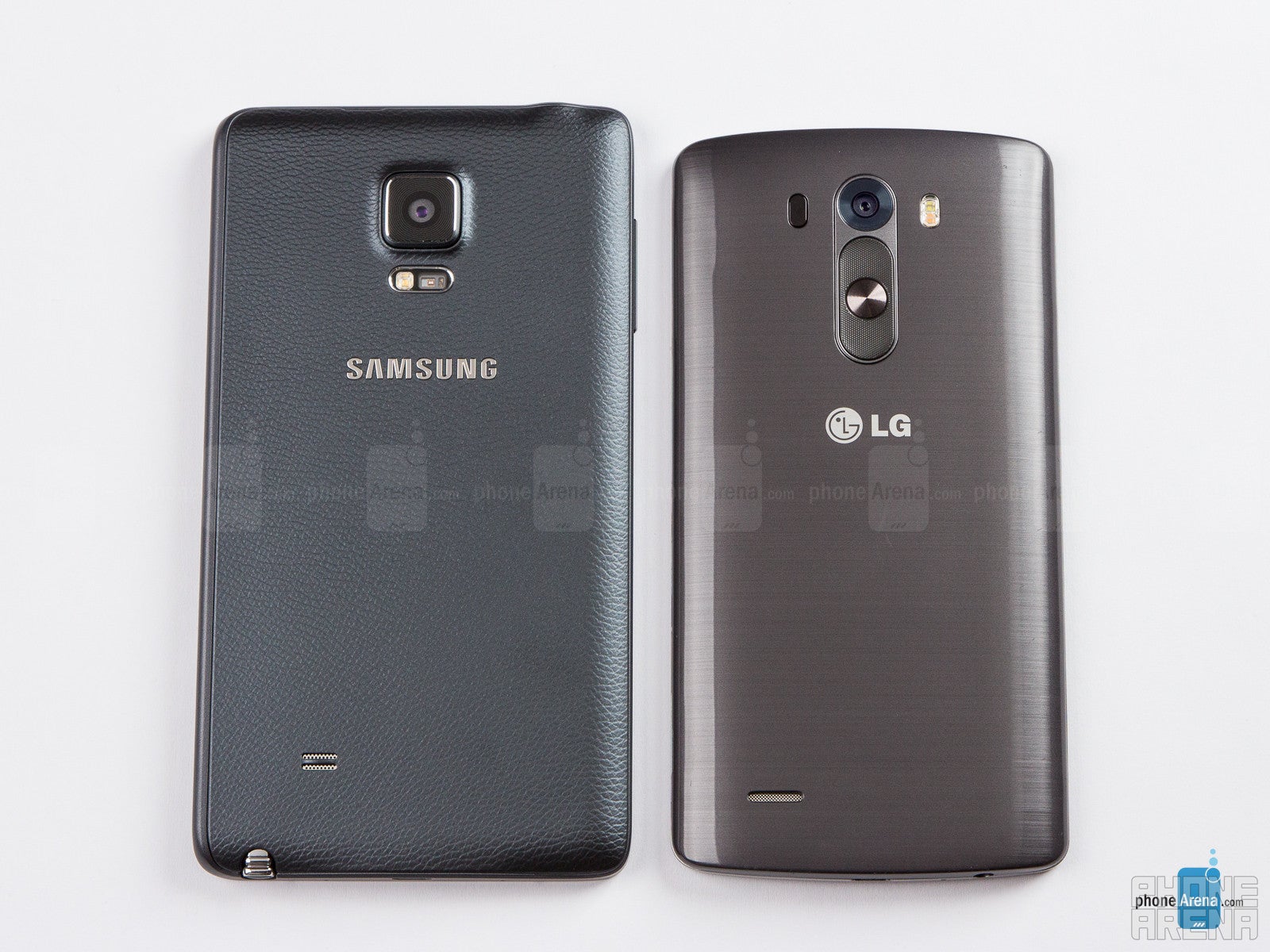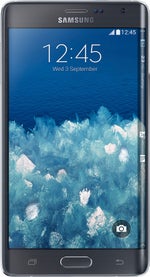Samsung Galaxy Note Edge vs LG G3

Introduction
One of the most compelling smartphones of late, the Samsung Galaxy Note Edge brought a fresh wave of innovation to the smartphone industry with its novel, unorthodox display that overlaps the right side bezel and provides a whole new functionality approach. But how does this undoubtedly niche device fare against the first smartphone from a well-known manufacturer to sport a pixel-rich Quad HD display, the LG G3? The edge aside, is the Galaxy Note Edge running circles around the G3? Moreover, should you choose Samsung's bizarre phablet over LG's current flagship offering ? We will pit these devices against one another and answer those questions.
Design
The Galaxy Note Edge feels unwieldy when compared with the slightly more compact G3
Well, both devices are quite different from one another in the design department. While both flaunt displays with roughly the same screen estate size (5.6 inches for the Galaxy Note Edge and 5.5 inches for the G3), LG's offering is a tad more compact and lightweight. On paper, the dimension differences may not seem like a big deal, but in reality the narrower LG G3 sits better in the hand than the thinner, yet broader and taller Galaxy Note Edge. The Galaxy Note Edge is by no means unwieldy, yet you will need to get accustomed to the so-called “edge” display of the phablet, as you may accidentally interact with it. That's why using the phone with one hand is a cumbersome task. The LG G3, being more compact, is slightly more friendly towards single-handed usage, but it's got its usability issues as well.
Typically for Samsung, the Galaxy Note Edge makes use of its signature design language, employing a hardware home button and a duo of capacitive ones at its lower end, paired with a faux leather back similar to the one of the Galaxy Note 4 that does not hold smudges of any kind, while the side frames employ metal, a relatively new and most welcome trend for Samsung. This combination of materials provides a fair amount of grip, not to mention that it feels somewhat more premium than the LG G3, which predominantly relies on polycarbonate plastic, with the back sporting a brushed metal-like finish that (thankfully) holds zero fingerprints.
As far as hardware buttons are concerned, the Galaxy Note Edge is unlike any other Samsung device, as its power/lock button rests on the top frame of the phone. The 151mm-tall silhouette of the phone renders this button rather unreachable with one hand. The hardware buttons of the G3 – the volume rocker and the power/lock button - are positioned at its rear, which might be a more convenient solution for some users.
Display
Both devices have their own strengths and weaknesses in the display section
We can find pixel-dense Quad HD displays on both the LG G3 and the Galaxy Note Edge. At 5.6”, the Super AMOLED display of the Samsung is slightly bigger than the 5.5” IPS LCD one of the G3. Thus, both have extremely high pixel density – 538ppi for the G3 and 525ppi for the Note Edge. The LG has an upper hand on paper, but in reality, both displays are extremely sharp and it is virtually impossible to discern any individual pixels with the naked eye.
The tests that we procured revealed that the display of the Galaxy Note Edge is a little more color accurate than the one in the LG G3 – Samsung's phablet has a color temperature of 6719 Kelvins, which is very close to the reference point of 6500K, while white colors on LG G3's display are slightly colder due to its temperature of 7099K. The Galaxy Note Edge also succeeds in matching more targets on the sRGB chart than the G3 does, which means that Samsung's offering tends to achieve more natural-looking colors. The color reproduction of the G3 is by no means bad, but it simply can't stand up to the overall accuracy of the Note Edge.
Another win for the novel phablet is its broader brightness amplitude – with a measured maximum brightness of 496 nits and a minimum one of just 1 nit, it is boasting a slightly larger brightness outpit than the G3, which scored 455-nit maximum and 9-nit minimum brightness results. As far as viewing angles are concerned, the LG G3 tends to exhibit lower brightness levels when viewed from lesser angles, whereas the same exercise distorts the color accuracy of the Samsung handset.
Interface and functionality
TouchWiz, the S Pen, and the novel display make the Note Edge more feature-rich than the G3
Both Android powerhouses run heavily-modified versions of Android 4.4.4 KitKat. The Galaxy Note Edge, in particular, is powered by the newest variation of Samsung's hate-it-or-love-it TouchWiz UI, roughly the same one that graces the more “mundane” relative of the Edge, the Galaxy Note 4. Normally, it's among the most functional stock UIs out there, but it's still not as smooth and polished as most of its rivals.
By default, the Edge screen of Samsung's phablet displays notifications from certain apps, and you can also fire up several apps that are normally found on the bottommost dock in other Android iterations, which saves you a bit of space on the main screen. By swiping the edge down, you can also access a slew of additional features and apps, like flashlight, ruler, etc. The S Pen further enriches the functionality of the device as well – with the refreshed array of Air Command features (the likes of Smart Select), it makes the Note Edge a worthy representative of the Note family. Multitasking in this iteration of TouchWiz is once again courtesy of the Multi Window software feature. The Note Edge also comes with Windowed apps – certain ones will allow you to resize and move them around. Over at the LG G3's camp, we have a multitasking feature as well - it is called Dual Window and, as a whole, offers a level of functionality that is pretty similar to Samsung's Multi Window.
LG, on the other hand, uses a new design language in its G3. It relies on subtle pastel colors and is also rather feature rich, but generally speaking, it is somewhat similar to TouchWiz as far as looks are concerned – pretty far away from stock Android. Nonetheless, unlike the Note Edge, the current LG flagship has zero hardware buttons at the front, so it relies on an on-screen navigation bar, which is customizable to some extent and allows you to add a fourth button to the default three.
As a whole, the UI of the G3 is definitely not as feature-laden as the one in the Galaxy Note Edge, but LG's offering has a feature that would have suited the Note Edge like a glove – the ability to lock/unlock the device with LG's Knock On feature. This could have been pretty useful to the not-so-user-friendly positioning of the hardware buttons of the Note Edge. We should also note that the LG G3 is devoid of a single-handed mode, while the Galaxy Note Edge has one. The latter also has a fingerprint scanner embedded in its home button, as well as a slew of additional sensors at the back (UV, SpO2 sensor; heart-rate monitor), while the G3 lacks such kind of features, which is by no means a bad thing, of course.
Processor and memory
True powerhouses on paper and in reality, but the Edge has an advantage
With Qualcomm's finest at the moment, the quad-core Snapdragon 805 SoC, running at up to 2.7GHz, and an Adreno 420 GPU in store, the hardware performance of the Samsung Galaxy Note Edge is superior to the one in the LG G3, which “only” sports a quad-core Snapdragon 801 8974-AC, humming at up to 2.5GHz, while an Adreno 330 takes care of graphics. Then again, the latter is just a step below Qualcomm's most potent chipset breed, so the difference is not that large. Memory-wise, the S Pen-toting Note Edge comes with either 32 or 64GB of internal storage, while the G3 comes with either 16 or 32GB. You get 3GB of RAM with the Note Edge, and if you opt for the 32GB version of the G3, you get the same amount of operational memory as the Note Edge. Both devices come with microSD slots, mind you.
Both devices feel quite snappy, with almost no lag or stutters while navigating through the interface, using the built-in functions, or even playing some of the heaviest 3D games available on Google Play. This was a no-brainer, as both devices have some really potent hardware muscle inside. It's hard to say which one performs better in real life and the differences are marginal. Yet, the G3 tends to show slight traces of lag in its UI, which is noticeable when you swipe through the app dialer, for example, but TouchWiz often suffers from similar issues, too.
However, the Galaxy Note Edge scored slightly higher results in almost all benchmark tests that we ran on it, but the LG G3 was stepping on its heels most of the time. Graphics-wise, the Note Edge performs better than the LG flagship, though this difference can't be easily spotted in most real-life scenarios. As a whole, the Galaxy Note Edge is, without the shadow of a doubt, packing more future-proof hardware.
Internet and connectivity
With their ultra-crisp displays and powerful insides, both the Note Edge and the LG G3 provide a pleasant web-surfing experience. Text appears great on both devices, even when zoomed in as much as possible. Apart from sporting Samsung and LG's own browsers, both handsets also come with Google Chrome preloaded. Whichever browser you choose, though, you will hardly have any issues.
As far as connectivity is concerned, you get an ample amount of features regardless of which device you pick. Both the Galaxy Note Edge and the LG G3 sport Wi-Fi 802.11 a, b, g, n, n 5GHz, and ac, GPS, A-GPS, GLONASS, and 4G LTE. The Note Edge, however, supports the most advanced speed standard at the moment, LTE-A Cat. 6 (download speed of up to 300Mbit/s), while the LG will only allow you to make use of LTE Cat. 4.
Camera
Both perform excellently, but the Note Edge has the upper hand by a small margin
Let's start with the raw specs of the snappers. The Galaxy Note Edge comes with the same snapper that adorns the Galaxy Note 4, which means that we are yet again dealing with a 16MP, 1/2.6" BSI sensor with an aperture of F/2.2. In LG G3's camp, we have a 13MP, 1/3.06” BSI sensor with an aperture of F/2.4. It's also important to mention that the G3 has a laser-aided autofocus that does its job extremely fast, but the Galaxy Note Edge is not a slouch in this department, too, as it comes with phase-detection autofocus, similar to the Note 4. By default, the Galaxy Note Edge shoots in a 16:9 ratio, while the LG G3 employs a 4:3 sensor.
Samsung's camera software is more feature-rich than the predominantly spartan one on the G3. The Note Edge comes with a surplus of shooting modes, functionalities, and features that are simply nowhere to be found in the G3, for the better or for the worse. Samsung's novel handset enables you to make use of Panorama, Selective focus, Beauty face, Virtual tour, Dual camera, Rear-cam selfie, etc. Manually adjusting various settings, such as ISO, exposure, and white balance is possible as well. In the meantime, the LG G3 is somewhat short on user-available shooting modes and options – Auto mode, Dual camera, Panorama, and Magic Focus are all there is.
Specs and features aside, the cameras of both phones perform well. The images from the Note Edge are a bit more detailed, but the images taken with the G3 have little to none digital noise, too. The color reproduction of the two cameras is top-notch, but the LG G3 tends to produce slightly colder images here or there. Sometimes, the G3 tends to add a slightly underexposed and a little too contrasty photos, but LG's flagship performs slightly better in the HDR segment. The Note Edge, on the other hand, creates slightly warmer and over-saturated photos when compared with the G3. When shooting macro, both devices perform extremely well, though the Note Edge is capable of adding just a tad more bokeh to the final shot. Samsung's phablet also produces more detailed panorama images.
The video-recording capabilities of both contenders are commendable, too. Both sport their own take on image stabilization – the Note Edge employs a combination between optical and digital stabilization, while the LG G3 solely relies on optical image stabilization. Both handsets are capable of shooting 1080p and 4K video (3840 x 2160 pixels) at 30fps as well. The LG G3, however, tends to add more “rolling shutter” effect. The Note Edge also does this, but on smaller scale (as a whole, it seems that the digital/optical image stabilization of the Note Edge outperforms the one of the LG G3). Samsung's phablet also produces more vibrant videos. Yet, the continuous autofocus on both devices leaves a lot to be desired – refocusing between background and foreground takes a while with both phones.
Multimedia
The Quad HD displays on both make multimedia consuming a pleasant experience
Needless to say, media looks outstanding on the pixel-rich displays of both devices. Thus, watching Orange Is The New Black or any other Netflix show will surely result in a more than pleasant experience. The stock video players on both devices provide a basic, yet perfectly sufficient level of functionality.
As far as audio is concerned, however, don't expect either the LG G3 or the Samsung Galaxy Note Edge to amaze you with their audio-performing capabilities. The reason is that their rear-positioned speakers are rather average at best, and neither their loudness nor sound quality are something to write home about – they'll just get the job done, but won't woo you. The music players of these rivals, on the other hand, offer are a sufficient amount of features and overall functionality. The one in the Galaxy Note Edge has slightly more options that G3's stock one, mind you.
Both devices have IR blasters at their topmost frames, which allow you to control a large number of supported devices and appliances. You can either make use of the pre-loaded IR-centric apps from both Samsung and LG or download a 3rd party one.
Call quality

Battery
The potent hardware and the 3,686,400 pixels aboard both devices mean that their batteries have some tough time ahead of them.

Conclusion
There you have it, almost all of the bad and the good concerning the first QHD monster that broke cover, the LG G3, and the ingenious and unorthodox S Pen-flaunting Samsung Galaxy Note Edge phablet. With its plastic/metal build and intriguing Edge display, S Pen stylus, and Snapdragon 805 in store, the Galaxy Note Edge will probably appeal to those who want to possess the latest and greatest available on the market. On the other hand, the LG G3 is a more “traditional” device, which employs a relatively compact form factor (considering the screen size), powerful hardware, and a set of features, such as Knock On/Knock Code, which make the device rather user-friendly.
Why should you choose the Samsung Galaxy Note Edge? Well, it's a more future-proof device, which outperforms the G3. If you are looking for a good cameraphone, then you might want to consider the Note Edge as well. The level of functionality its S Pen totes cannot be matched by the G3, too. Nonetheless, all of this takes its toll at the checkout – the Galaxy Note Edge bears a higher price tag than the G3, both unlocked ($945.95) and with a two-year contract ($399).
And why would you want to get LG's current flagship? Apart from being slightly easier to handle and use, the device is pocket-friendlier, and just as versatile in most essential categories. Generally, it does not lag that much behind the Note Edge in any aspect, and even surpasses it in some. We should also not forget that the G3 will damage your wallet less - $599 for the unlocked version and $149.99-$199.99 with a two-year commitment.
If you are looking for a top-of-the-line QHD handset with monstrous specs sheet, then you can go wrong with neither of these two devices, yet you need to ask yourself a very simple question: “Is the undoubtedly-intriguing screen of the Samsung Galaxy Note Edge worth a few hundred bucks over the LG G3?”
Follow us on Google News























Things that are NOT allowed:
To help keep our community safe and free from spam, we apply temporary limits to newly created accounts: